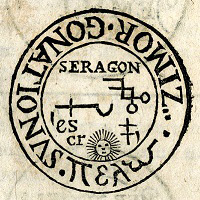Now available online, Witchcraft, Women & the Healing Arts in the Early Modern Period brings together materials from the Reynolds-Finley Historical Library, Lister Hill Library of the Health Sciences, and Mervyn H. Sterne Library.
Various topics covered include accusations of witchcraft against midwives and other folk healers, supernatural themes of alchemy and astrology found in academic medicine of the time, as well as the possibility that ergot poisoning contributed to the mass hysteria surrounding the Salem witch trials. Early modern conceptions of witchcraft, its practices and traditions, are also addressed.
Through the ages, the practices that came to be associated with witchcraft provided a connection to both the natural and the supernatural forces of the universe. However, beginning in the 13th century, witches became identified as those possessed by or in allegiance with the Devil or demons. Between the late 1400s and the mid-1700s, circulating guidebooks on how to properly identify witches, as well as growing social discord, often targeted individuals who practiced the healing arts, and particularly female healers, during the well-known witch hunts and trials.

